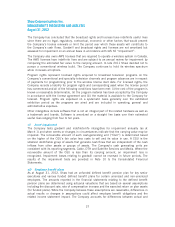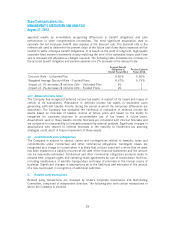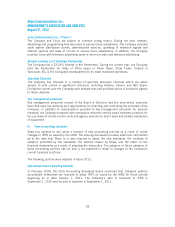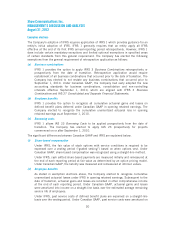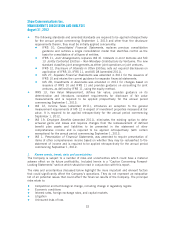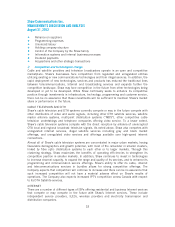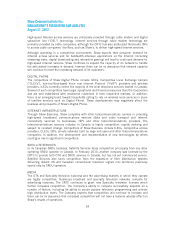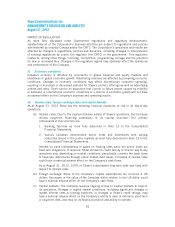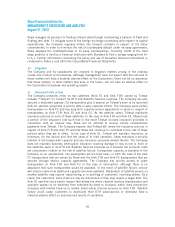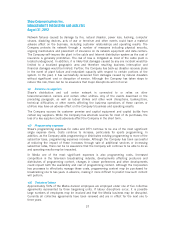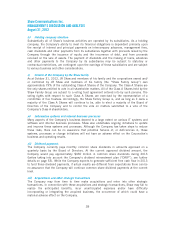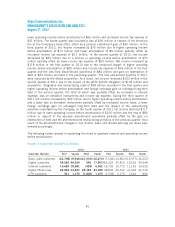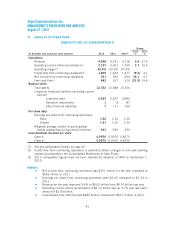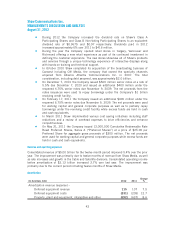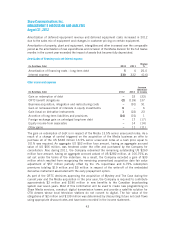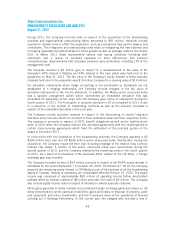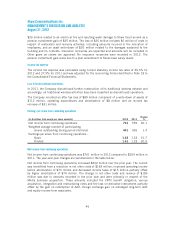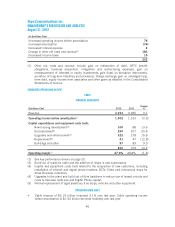Shaw 2012 Annual Report Download - page 41
Download and view the complete annual report
Please find page 41 of the 2012 Shaw annual report below. You can navigate through the pages in the report by either clicking on the pages listed below, or by using the keyword search tool below to find specific information within the annual report.Shaw Communications Inc.
MANAGEMENT’S DISCUSSION AND ANALYSIS
August 31, 2012
Network failures caused by damage by fire, natural disaster, power loss, hacking, computer
viruses, disabling devices, acts of war or terrorism and other events could have a material
adverse affect on the business, including customer relationships and operating results. The
Company protects its network through a number of measures including physical security,
ongoing maintenance and placement of insurance on its network equipment and data centers.
The Company self-insures the plant in the cable and Internet distribution system as the cost of
insurance is generally prohibitive. The risk of loss is mitigated as most of the cable plant is
located underground. In addition, it is likely that damages caused by any one incident would be
limited to a localized geographic area and therefore resulting business interruption and
financial damages would be limited. Further, the Company has back-up disaster recovery plans
in the event of plant failure and redundant capacity with respect to certain portions of the
system. In the past, it has successfully recovered from damages caused by natural disasters
without significant cost or disruption of service. Although the Company has taken steps to
reduce this risk, there can be no assurance that major disruptions will not occur.
vi) Reliance on suppliers
Shaw’s distribution and call center network is connected to or relies on other
telecommunication carriers and certain other utilities. Any of the events described in the
preceding paragraph, as well as labour strikes and other work disruptions, bankruptcies,
technical difficulties or other events affecting the business operations of these carriers or
utilities may have an adverse effect on the Company’s business and operating results.
The Company sources its customer premise and capital equipment and capital builds from
certain key suppliers. While the Company has alternate sources for most of its purchases, the
loss of a key supplier could adversely affect the Company in the short term.
vii) Programming expenses
Shaw’s programming expenses for cable and DTH continue to be one of the most significant
single expense items. Costs continue to increase, particularly for sports programming. In
addition, as the Company adds programming or distributes existing programming to more of the
subscriber base, programming expenses increase. Although the Company has been successful
at reducing the impact of these increases through sale of additional services or increasing
subscriber rates, there can be no assurance that the Company will continue to be able to do so
and operating results may be impacted.
In Media one of the most significant expenses is also programming costs. Increased
competition in the television broadcasting industry, developments affecting producers and
distributors of programming content, changes in viewer preferences and other developments
could impact both the availability and cost of programming content. Although the Corporation
has processes to effectively manage these costs, programming content may be purchased for
broadcasting one to two years in advance, making it more difficult to predict how such content
will perform.
viii) Unionized labour
Approximately 50% of the Media division employees are employed under one of five collective
agreements represented by three bargaining units. If labour disruptions occur, it is possible
large numbers of employees may be involved and that the Media business may be disrupted.
Currently all collective agreements have been renewed and are in effect for the next one to
three years.
37


